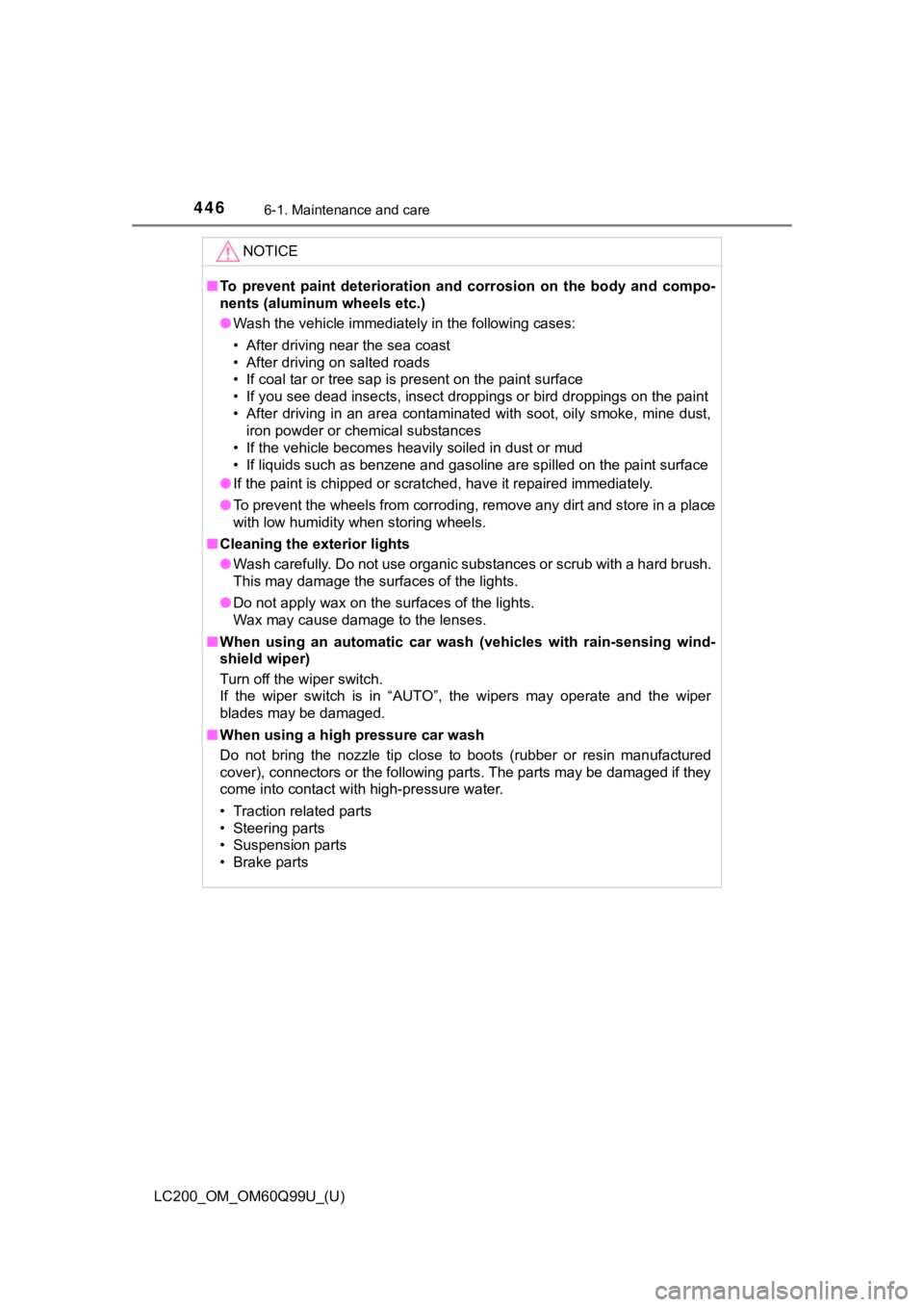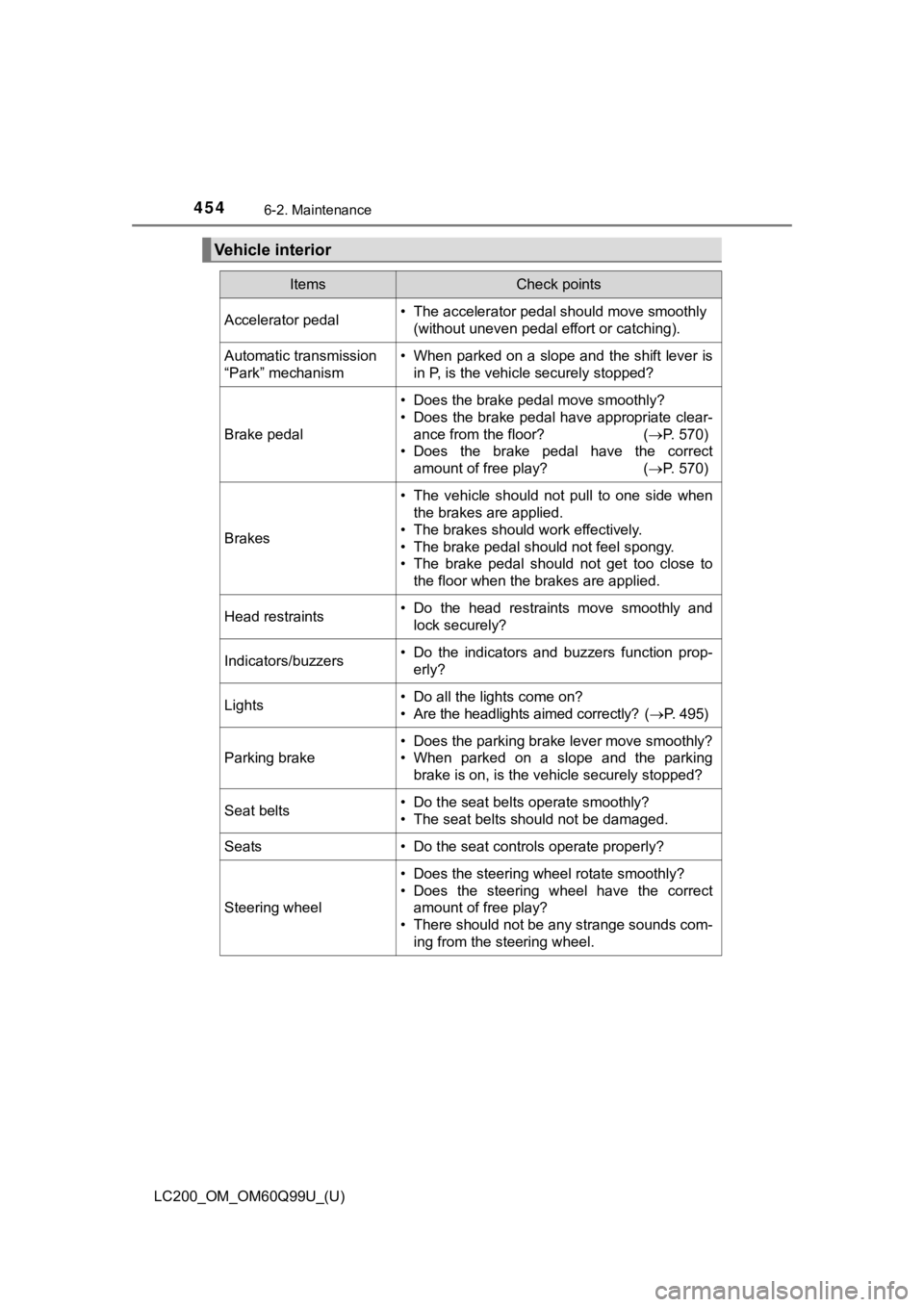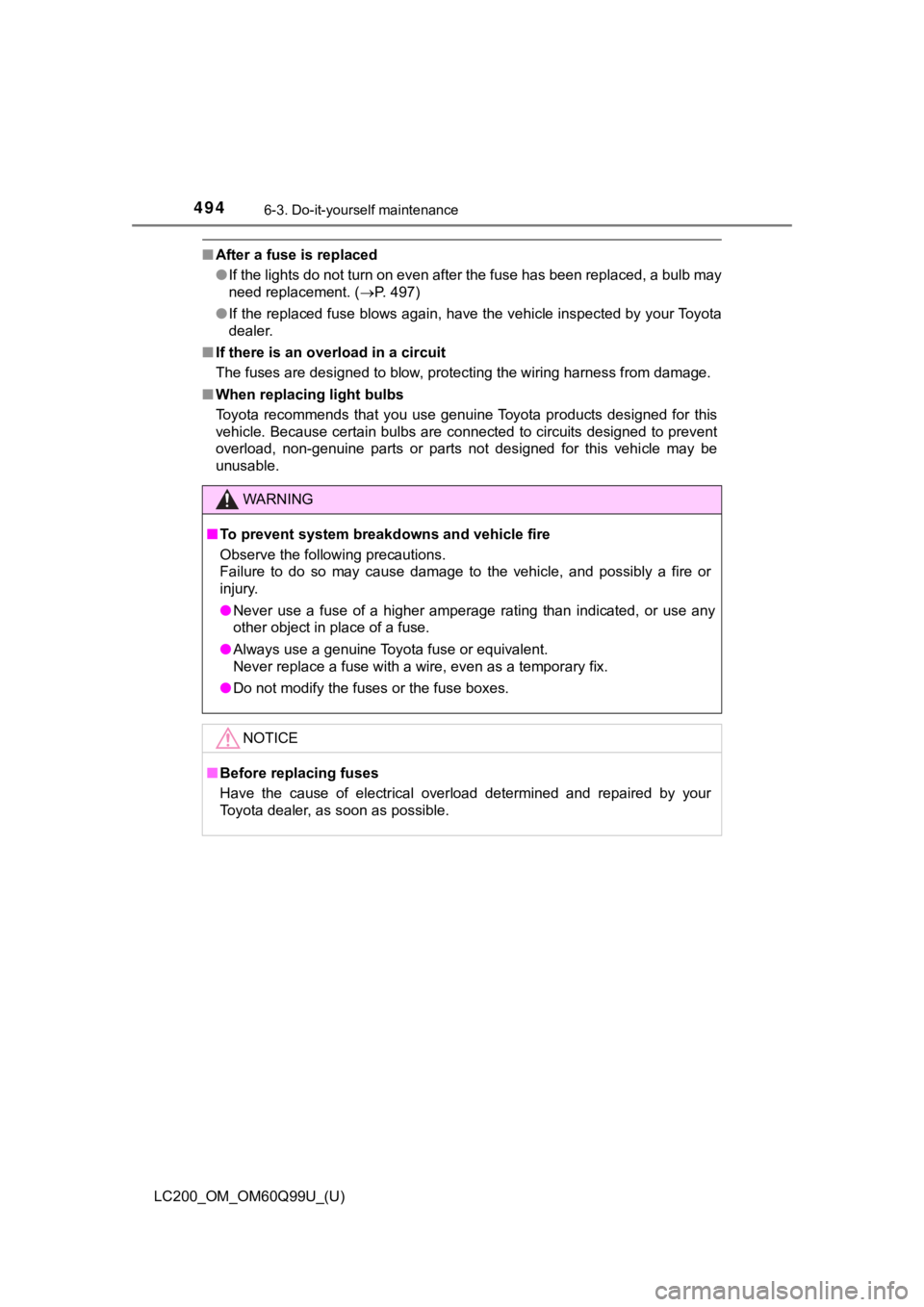Page 446 of 624

446
LC200_OM_OM60Q99U_(U)
6-1. Maintenance and care
NOTICE
■To prevent paint deterioration an d corrosion on the body and compo-
nents (aluminum wheels etc.)
● Wash the vehicle immediately in the following cases:
• After driving near the sea coast
• After driving on salted roads
• If coal tar or tree sap is present on the paint surface
• If you see dead insects, insect droppings or bird droppings on the paint
• After driving in an area contaminated with soot, oily smoke, mine dust, iron powder or chemical substances
• If the vehicle becomes heavily soiled in dust or mud
• If liquids such as benzene and gasoline are spilled on the pai nt surface
● If the paint is chipped or scratched, have it repaired immediat ely.
● To prevent the wheels from corroding, remove any dirt and store in a place
with low humidity when storing wheels.
■ Cleaning the exterior lights
● Wash carefully. Do not use organic substances or scrub with a h ard brush.
This may damage the surfaces of the lights.
● Do not apply wax on the surfaces of the lights.
Wax may cause damage to the lenses.
■ When using an automatic car wash (vehicles with rain-sensing wi nd-
shield wiper)
Turn off the wiper switch.
If the wiper switch is in “AUTO”, the wipers may operate and th e wiper
blades may be damaged.
■ When using a high pressure car wash
Do not bring the nozzle tip close to boots (rubber or resin man ufactured
cover), connectors or the following parts. The parts may be damaged if they
come into contact with high-pressure water.
• Traction related parts
• Steering parts
• Suspension parts
• Brake parts
Page 454 of 624

454
LC200_OM_OM60Q99U_(U)
6-2. Maintenance
Vehicle interior
ItemsCheck points
Accelerator pedal• The accelerator pedal should move smoothly (without uneven pedal effort or catching).
Automatic transmission
“Park” mechanism• When parked on a slope and the shift lever isin P, is the vehicle securely stopped?
Brake pedal
• Does the brake pedal move smoothly?
• Does the brake pedal have appropriate clear-
ance from the floor? ( P. 570)
• Does the brake pedal have the correct amount of free play? ( P. 570)
Brakes
• The vehicle should not pull to one side when
the brakes are applied.
• The brakes should work effectively.
• The brake pedal should not feel spongy.
• The brake pedal should not get too close to the floor when the brakes are applied.
Head restraints• Do the head restraints move smoothly andlock securely?
Indicators/buzzers• Do the indicators and buzzers function prop-erly?
Lights• Do all the lights come on?
• Are the headlights aimed correctly? ( P. 4 9 5 )
Parking brake
• Does the parking brake lever move smoothly?
• When parked on a slope and the parking
brake is on, is the vehicle securely stopped?
Seat belts• Do the seat belts operate smoothly?
• The seat belts should not be damaged.
Seats• Do the seat controls operate properly?
Steering wheel
• Does the steering wheel rotate smoothly?
• Does the steering wheel have the correctamount of free play?
• There should not be any strange sounds com- ing from the steering wheel.
Page 494 of 624

494
LC200_OM_OM60Q99U_(U)
6-3. Do-it-yourself maintenance
■After a fuse is replaced
●If the lights do not turn on even after the fuse has been repla ced, a bulb may
need replacement. ( P. 497)
● If the replaced fuse blows again, have the vehicle inspected by your Toyota
dealer.
■ If there is an overload in a circuit
The fuses are designed to blow, protecting the wiring harness f rom damage.
■ When replacing light bulbs
Toyota recommends that you use genuine Toyota products designed for this
vehicle. Because certain bulbs are connected to circuits designed to prevent
overload, non-genuine parts or parts not designed for this vehicle may be
unusable.
WARNING
■ To prevent system breakdowns and vehicle fire
Observe the following precautions.
Failure to do so may cause damage to the vehicle, and possibly a fire or
injury.
● Never use a fuse of a higher amperage rating than indicated, or use any
other object in place of a fuse.
● Always use a genuine Toyota fuse or equivalent.
Never replace a fuse with a wire, even as a temporary fix.
● Do not modify the fuses or the fuse boxes.
NOTICE
■Before replacing fuses
Have the cause of electrical overload determined and repaired b y your
Toyota dealer, as soon as possible.
Page 500 of 624
500
LC200_OM_OM60Q99U_(U)
6-3. Do-it-yourself maintenance
■Front turn signal lightsFor the left side only:
Remove the securing clip
and move the washer fluid
filler opening.
To allow enough working
space, remove the bulb base
of the front side marker light.
Wrap the removed bulb base
with cloth to prevent damage to
the bulb base.
Unplug the connector while
depressing the lock release.
Turn the bulb base counter-
clockwise.
1
2
3
4
Page 504 of 624
504
LC200_OM_OM60Q99U_(U)
6-3. Do-it-yourself maintenance
■Rear turn signal lightsOpen the back door and
attach protective tape under
the light unit. (Use masking
tape. Do not use any duct
tape, as duct tape may leave
markings.)
Remove the cover.
Remove the 2 bolts and lamp
assembly.
1
2
3
Page 506 of 624

506
LC200_OM_OM60Q99U_(U)
6-3. Do-it-yourself maintenance
■Replacing the following bulbs
If any of the lights listed below has burnt out, have it replaced by
your Toyota dealer.
● Headlights/daytime running lights
● Parking lights
● Fog lights
● Side turn signal lights
● High mounted stoplight
● Stop/tail lights
● Stop lights
● Rear side marker lights
● License plate lights
■LED lights
The headlights/daytime running lights, parking lights, fog lights, side turn sig-
nal lights, high mounted stoplight, stop/tail lights, stop ligh ts, rear side marker
lights and license plate lights consist of a number of LEDs. If any of the LEDs
burn out, take your vehicle to your Toyota dealer to have the l ight replaced.
■ Condensation build-up on the inside of the lens
Temporary condensation build-up on the inside of the headlight lens does not
indicate a malfunction. Contact your Toyota dealer for more information in the
following situations:
● Large drops of water are built up on the inside of the lens.
● Water has built up inside the headlight.
■ When replacing light bulbs
P. 494
Page 507 of 624

LC200_OM_OM60Q99U_(U)
5076-3. Do-it-yourself maintenance
6
Maintenance and care
WARNING
■Replacing light bulbs
● Turn off the headlights. Do not attempt to replace the bulb imm ediately
after turning off the headlights.
The bulbs become very hot and may cause burns.
● Do not touch the glass portion of the light bulb with bare hand s. When it is
unavoidable to hold the glass portion, use and hold with a clea n dry cloth
to avoid getting moisture and oils on the bulb.
Also, if the bulb is scratched or dropped, it may blow out or crack.
● Fully install light bulbs and any parts used to secure them. Fa ilure to do so
may result in heat damage, fire, or water entering the headligh t unit. This
may damage the headlights or cause condensation to build up on the lens.
● Do not attempt to repair or disassemble light bulbs, connectors , electric
circuits or component parts.
Doing so may result in death or serious injury due to electric shock.
■ To prevent damage or fire
● Make sure bulbs are fully seated and locked.
● Check the wattage of the bulb before installing to prevent heat damage.
Page 510 of 624
510
LC200_OM_OM60Q99U_(U)
7-1. Essential information
Emergency flashers
Press the switch.
All the turn signal lights will flash.
To turn them off, press the switch
once again.
■Emergency flashers
If the emergency flashers are used for a long time while the en gine is not
operating, the battery may discharge.
The emergency flashers are used to warn other drivers when the
vehicle has to be st opped in the road due to a breakdown, etc.